CUCKOO Compact Automatic Bread Maker CBM-AAB101S User Manual

IMPORTANT SAFEGUARDS
To prevent personal injury or property damage, read and follow all instructions and warnings. When using electrical appliances, basic safety precautions should always be followed including the following:
- When using electrical appliances, basic safety precautions should always be followed including the following:
- Read all instructions.
- Do not touch hot surfaces. Use handle or knobs. Always use hot pads or oven mitts when handling hot bread and bread pan.
- To protect against electric shock, do not immerse cord, plugs, or other electric parts in water or other liquids.
- Close supervision is necessary when this appliance is used by or near children.
- Unplug the appliance from the outlet when not in use or before cleaning. Allow to cool before attaching or removing parts.
- Do not operate the appliance if the plug or cord is damaged, if the device malfunctions, or if it’s dropped or damaged by any manner. If you experience any problems with your appliance, unplug it immediately from the electrical outlet. For service information see warranty page.
- The use of accessory attachments not recommended by West Bend may cause fire, electric shock, or injury to persons.
- Do not use this appliance outdoors.
- Do not let cord hang over the edge of a table or counter, or touch hot surfaces.
- Do not place on or near a hot gas or electric burner, or in a heated oven.
- Use extra precaution when moving the bread maker during operation.
- To disconnect, turn control to “OFF,” then remove plug from wall outlet.
- Do not use appliance other than its intended purpose.
- Avoid touching moving parts.
- Do not let the cord touch any hot surfaces.
- This appliance has a polarized plug (one blade is wider than the other). To reduce the risk of electric shock, this plug is intended to only fit the polarized outlet one way. If the plug does not completely fit into the outlet, reverse the plug. If it still does not fit, contact a qualified electrician. Do not attempt to modify the plug in any way.
- Set the bread pan on a hot pad, trivet, or other heat protective surface. Do not set hot bread pan directly onto the counter, table, or other surface.
- Do not put hand inside oven chamber after bread pan is removed. Heating unit will still be hot.
- Do not use your bread maker with a converter or transformer. This will destroy the electronic controls.
- Do not attempt to repair this appliance yourself.
- A short power-supply cord is included to reduce any risks from entanglement or tripping over a longer cord.
- Longer, detachable power-supply cords or extension cords are available. They may be used if proper care is exercised. Using an extension cord is not recommended. If you must use one though, the marked electrical rating of the detachable power-supply cord or extension cord should be at least as great as the electrical rating of the appliance. If you’re using a grounded appliance, then use a grounded 3 wire extension cord. To avoid tripping or any unsafe pulling, the cord should not hang over any counter or table top.
- For household use only.
- This appliance is not intended for those (including children) who have reduced physical, sensory, or mental capabilities; or those who lack experience or knowledge of the product unless they supervised or given instruction by those who are responsible for their safety.
- Children should be supervised to ensure they do not misuse the appliance.
- This appliance is not designed to operate with any external timer or separate remote-control system.
SPECIFICATIONS
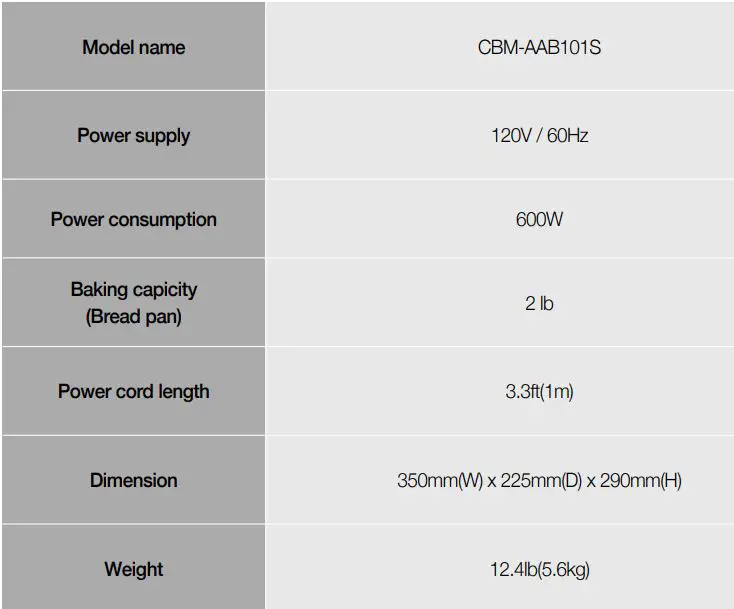
PART DESCRIPTION
Parts Accessories
Accessories

QUICK GUIDE
![]()
HOW TO ASSEMBLE THE BREAD PAN(1) To use the bread pan handle, turn the bread pan counter-clockwise, then pull it out of the device.
![]() (2) Place the bread pan back into the bread maker. Ensure the pan is firmly locked into place by turning it clockwise. Then, close the lid.NOTE : Bread pan must lock into place for proper mixing andkneading.
(2) Place the bread pan back into the bread maker. Ensure the pan is firmly locked into place by turning it clockwise. Then, close the lid.NOTE : Bread pan must lock into place for proper mixing andkneading.
![]()
![]()
![]()
![]()
![]()
![]()
![]()
Using the fruit & nut dispenserIf you wish to add nuts or seeds to your loaf, it is not recommended to dispense them into the flour at first preparation. This may cause the nuts or seeds to lose flavor and texture due to over stirring. The automatic dispenser function will help you add fruits, nuts, raisins, or other add-ins without waiting by the bread maker. Pour the nuts or seeds in the dispenser, then install it below the lid. After installation, close the lid and start the program. After approximately 30 minutes (time may differ) of baking, the nut dispenser will operate 3 times. To ensure all contents are dispensed, the dispenser will push the bottom cover open. The dispensing function is automatically set in menus 1-7 and 13.
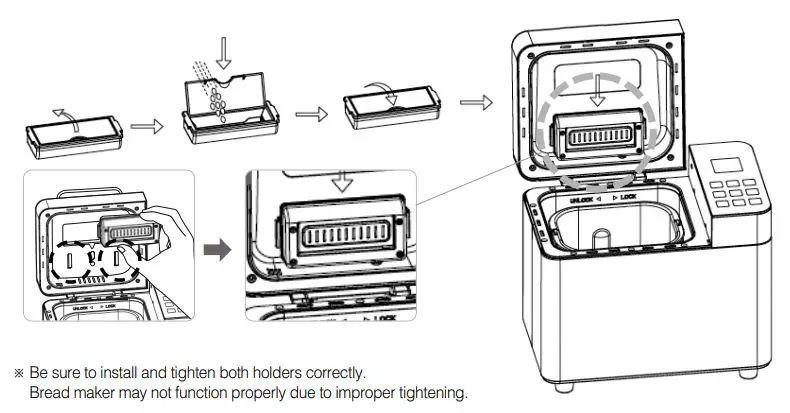


REMOVING BREADOven mitts should be used as the bread pan and baking chamber will be hot. To remove the bread pan, lift the handle, turn it counterclockwise to unlock, and lift the pan straight up from the base of the chamber. After you remove the pan, carefully shake the bread upside down until it falls out. Let the bread cool on a wirer rack for 10 minutes before you slice it with a bread knife.TIP: If the kneading paddle is stuck in the loaf, remove it with a hook (or kneading paddle remover).



TIP : If needed, when the paddle signal alerts, pause the unit by pressing the START/STOP button.
HOW TO CLEAN AND USE ENVIRONMENT
CLEANING YOUR BREADMAKER
- Unplug the cord from the electrical outlet and allow the appliance to cool completely before cleaning.
- After the bread is removed from the bread pan, and the pan has cooled, fill it half-full with warm water and a small amount of dish soap. Allow the bread pan to soak for 5 to 20 minutes, or until the knead blades can be lifted off of the shafts. You may need to twist the knead blades slightly to loosen. If the knead blades are difficult to remove after soaking, secure the cross bar on the underside of the bread pan while twisting the knead blades to loosen. Wash the inside of the bread pan and knead blades with a soft cloth, then rinse and dry. Use a mild detergent. Never use chemical cleaning agents, oven cleaners, abrasive scouring pads, or cleansers on the bread pan or knead blades as it may damage the coating or finish. Replace the knead blades on the shaft.
- Never immerse the bread pan in water or wash in an automatic dishwasher as it may damage the bearing that turns the knead blade. If necessary, wipe the inside of the oven chamber and the outside surfaces of the bread maker with a damp cloth. Never dip the appliance or fill the baking compartment with water! The lid cannot be removed for cleaning.
USE ENVIRONMENT Although the bread maker can work well in a wide range of temperatures, loaf sizes may differ depending on room temperature. We suggest that the room temperature should be between 15 to 34.
FUNCTION INTRODUCTION
Control Panel Description
AFTER POWER ON
Plug the bread maker into a power supply. A beep will sound and “3:10” will display. The colon will flash, but the “3” and “10” will not. “1” is the default program. The arrows will point to “1½LB” and “MEDIUM” as they are default settings.


START/STOP BUTTONPress the START/STOP button once to start a program. The indicator will light up, and the colon in the time display begin to flash and the program will start. Any other button is inactivated except the START/STOP button after a program has begun.Press the START/STOP button for 0.5 seconds to pause the program. If there is no operation within 3 minutes, the program will continue processing until the setting program is completed. Press and hold the START/STOP button for 3 seconds to cancel a program. This will help prevent any unintentional disruption to the operating program. To remove bread, press the START/STOP button to end baking cycle.


PREPROGRAMMED MENUPress MENU button to select your desired programs. The program will change each time you press the MENU button (A short beep will accompany each time you press the button). When cycling, each corresponding program number will be shown on the LCD display.
CRUST COLORPress COLOR button to select your desired setting: Light, Medium, or Dark crust . This button is adjustable in programs menu 1-7
WEIGHTPress the Weight button to choose your desired gross weight (1LB, 1½LB, 2LB) This button is adjustable in programs Menu 1-7
DELAY TIMER(“+ or ”)Use the DELAY TIMER feature to start the bread maker at a later time. Press ” + or ” buttons to increase the cycle time shown on the LCD display. The delay timer can add up to 15 hours. Set time will also include the breading making process.
NOTES:
▶ Set the Delay Time after selecting PROGRAM MENU, WEIGHT, and CRUST COLOR.▶ Do not use the timer function with recipes that include dairy or other ingredients, such as eggs, milk, cream, or cheese.
▶ Press the “+ or ” buttons to decide when you want your bread will finish. Please note the delay time should include baking time. After baking program is complete, the bread maker will shift to its Keep Warm setting for 1 hour. Before you start making the bread, ensure the program and crust color are selected first. Press the “+ or ” to change the delay time in 10-minute increments. The maximum delay time is 15 hours.
POWER INTERRUPTIONIn the event of a power outage, the process of making bread will automatically continue within 10 minutes, even if you don’t press the START/STOP button. If the interruption time is longer than 15 minutes, the unit will not continue running and the LCD display will revert back to its default setting. If the dough has started rising, discard the ingredients in the bread pan and start over. If the dough has not started rising when power was interrupted, press the START/STOP button to continue the program from the beginning.
WARNING DISPLAYThis warning means that the temperature inside of the bread pan is too high. Press START/STOP button to stop the program, unplug the power cord, open the top lid, and let the machine cool down completely for 10-20 minutes before restarting.This warning means that the temperature sensor is disconnected. Press the START/STOP button to stop the program, then unplug the power cord. Please check the sensor with the nearest authorized service agent for any examination, repair, or electrical /mechanical adjustment.
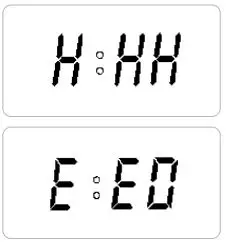

KEEP WARMAfter baking program is complete, the bread machine will beep 10 times and shift to its Keep Warm setting for 1 hour. After 60 minutes, 0:00 will be shown on the LCD display. To cancel the Keep Warm setting, press and hold the START/STOP button for 3 seconds.TIP: Removing bread immediately after baking program is complete will prevent the crust from getting darker.
BEFORE THE FIRST USEWash and dry the bread pan and kneading paddleNote: Do not use metal utensils in bread pan since they may damage the non-stick surface.CAUTION! Falling Object Hazard. Bread maker can wobble and walk during kneading cycle. Always position it in the center of counter away from the edge.
- Check for any missing or damaged parts.
- Clean all the parts according to “CLEANING AND MAINTENANCE”.
- Set the bread maker on bake mode and let it bake empty for about 10 minutes. Once you let it cool, clean all the detached parts again. The appliance may emit a little smoke and/or odor when you turn it on after the first time. This is normal, and it will subside after the first or second use. Make sure the appliance has sufficient ventilation.
- Once you dry all parts thoroughly and assemble them, the appliance is ready for use.
DETAILED BREAD MAKING INSTRUCTIONS
- To use the bread pan handle, turn the bread pan counter-clockwise, then pull it out of the device.



- Press the kneading paddle into the drive shaft located inside the bread pan.


- Add the ingredients to the bread pan in order listed in the recipe. First, add the liquids, sugar, and salt; then the flour; and last the yeast.


- Carefully measure and add ingredients to the bread pan in the EXACT order given in the recipe.


- NOTE: Make a small indent on top of the flour with your finger, then add yeast into it. Make sure that yeast does not come into contact with any salt or liquids.TIP: Before you begin, pre-measure all ingredients, including add-ins (nuts, raisins, etc.).
- Place the bread pan back into the bread maker. Ensure the pan is firmly locked into place by turning it clockwise. Then, close the lid.NOTE: Bread pan must be locked into place for proper mixing and kneading.



- Once you plug in the appliance, you’ll hear a beep and the LCD display will default to program 1.
- Continuously press the PROGRAM MENU button until your desired program is displayed.
- Press the WEIGHT button to cycle the arrow through the 1LB, 1½LB, or 2LB options. (WEIGHT is not an option in program 8-15.)
- Press the CRUST button to move the arrow to desired setting: Light, Medium, Dark crust.(Crust is not adjustable in program 8-15.)
- If desired, set the DELAY TIMER button. Press + and buttons to adjust the time shown on the LCD display.(Delay function is not available in program 13)
- NOTE: Do not use the delayed timer when adding dairy, eggs, etc. You may skip this step if you want to start your bread maker immediately.
- Press the START/STOP button once to start program. The bread maker will beep once as the indicator arrows and colon between the “3” and “10” will start blinking. The kneading paddle will begin mixing your ingredients. If you set the delay timer, the kneading paddle will not mix ingredients until it reaches your set time.
- Once the process is complete, the maker will sound 10 beeps and then shift to its keep warm setting for 1 hour. Press and hold the START/STOP button for 3 seconds to end the Keep Warm setting.TIP : If needed, when the paddle signal alerts, pause the unit by pressing the START/STOP button. After pausing, remove the dough and kneading paddle, reshape the dough, and replace the bread pan. To continue, press the START/STOP button
- Let the bread pan cool down slightly before moving the bread. Using oven mitts, carefully turn the bread pan counterclockwise to unlock. Then, lift up the handle and remove the pan from the machine.CAUTION: the Bread pan and bread may be very hot! Always handle with care.


- Using oven mitts, turn the bread pan upside down(with the bread pan handle folded down) onto a wire cooling rack or clean cooking surface and gently shake until bread falls out. Use a non-stick spatula to gently loosen the sides of the bread from the bread pan.
- Let the bread cool for about 20 minutes before slicing. It is recommended to slice bread with an electric or dentate cutter rather than a fruit or kitchen knife as it may lead to deformation.
- If kneading paddle gets stuck inside the bread, gently pry it out using a spatula or small utensil. Never use your hands to remove the kneading paddle as the bread is hot. When not in use or if operation is complete, unplug the power cord. NOTE: Store remaining bread in a sealed plastic bag for up to three days at room temperature. For longer storage time, placed seal plastic bag in a refrigerator for up to 10 days.
Using the fruit & nut dispenserIf you wish to add nuts or seeds to your loaf, it is not recommended to dispense them into the flour at first preparation. This may cause the nuts or seeds to lose flavor and texture due to over stirring. The automatic dispenser function will help you add fruits, nuts, raisins, or other add-ins without waiting by the bread maker. Pour the nuts or seeds in the dispenser, then install it below the lid. After installation, close the lid and start the program. After approximately 30 minutes (time may differ) of baking, the nut dispenser will operate 3 times. To ensure all contents are dispensed, the dispenser will push the bottom cover open. The dispensing function is automatically set in menus 1-7 and 13.



REMOVING BREADOven mitts should be used as the bread pan and baking chamber will be hot. To remove the bread pan, lift the handle, turn it counterclockwise to unlock, and lift the pan straight up from the base of the chamber. After you remove the pan, carefully shake the bread upside down until it falls out. Let the bread cool on a wirer rack for 10 minutes before you slice it with a bread knife. TIP: If the kneading paddle is stuck in the loaf, remove it with a hook (or kneading paddle remover).



TIP : If needed, when the paddle signal alerts, pause the unit by pressing the START/STOP button. After pausing, remove the dough and kneading paddle, reshape the dough, and replace the bread pan. To continue, press the START/STOP button
INGREDIENTS INTRODUCTION
- Bread FlourBread flour is the most important ingredient in making bread. It is also recommended to include in most yeast bread recipes. Also called high-gluten flour due to its higher gluten and protein contents, this can help keep the bread from collapsing after rising. Flour varies by region. Bread flour has a higher gluten content than all-purpose flour, so it can be used for baking larger bread loafs with higher inner fiber content.
- All-Purpose FlourAll-purpose flower contains no baking powder. This flour is suitable for “quick breads”, or bread made with the quick settings. Bread flour is better suited for yeast breads.
- Whole-Wheat FlourWhole-wheat flour is grounded from an entire wheat kernel. Bread that contains whole-wheat flour typically has higher fiber and nutritional contents. Whole-wheat tends to be heavier than other flours. As a result, loaves are usually smaller in size and are heavier in texture. Whole-wheat flour contains wheat skin and gluten. Many recipes add whole-Wheat flour or Bread Flour for better baking results.
- Black Wheat FlourAlso called “rye flour”, black wheat flour contains a high amount of fiber similar to whole-wheat flour. To increase loaf size, black wheat flour must be combined with a large amount of bread flour.
- Self-rising flourTypically used for baking cakes, self-rising flour contains baking powder. Do not use self-rising flour with yeast.
- Corn flour and oatmeal flourCorn flour and oatmeal flour are grounded from corn and oatmeal separately. They are used as additive ingredients for making rough bread. They help enhance flavor and texture.
- SugarSometimes described as “food” for yeast, sugar increases the sweetness and color of your bread. It is also a crucial element in the bread rising process. White sugar is typically used. However, some recipes may call for brown sugar, powdered sugar, or cotton sugar.
- YeastYeast is a living organism that should be kept in the refrigerator to maintain its freshness. It needs carbohydrates found in sugar and flour for nourishment. Yeast used in bread makers are sometimes sold under several different names: Bread machine yeast (preferred), active-dry yeast, and instant yeast. After the yeasting process, the yeast will produce carbon dioxide. The carbon dioxide will expand bread and soften the inner fibers.1 tbsp. dry yeast =3 tsp dry yeast1 tbsp. dry yeast =15ml yeast1 tsp dry yeast =5mlBefore using, check the expiration date and storage time of the yeast. Store the yeast back into refrigerator immediately after each use. If not, the higher temperature may kill the fungus needed for bread rising.TIP: To check on your yeast to see if it is fresh and active:(1) Pour 1 cup (237ml) of warm water (45-50) into a measuring cup.(2) Add 1 teaspoon (5ml) of white sugar into the cup and stir. Then, add 1 tablespoon (15ml) of yeast into the water.(3) Place the measuring cup in a warm place for about 10min. Do not stir the water.(4) Fresh, active yeast will begin to bubble or “grow”. If it does not, the yeast is dead or inactive.
- SaltAlthough bread tends to grow larger when salt isn’t added to the recipe, do not add too much salt to your recipe.
- EggEggs can improve the bread’s texture, add more nourishment, and increase its size. The egg must be whisked in with the other liquid ingredients.
- Grease, Butter and Vegetable OilGrease can soften the bread and extend its storage life. Butter should be melted or chopped into small pieces before adding to liquid.
- Baking PowderBaking powder is used for rising the Ultra Fast bread and cake. When using baking powder, rising time is not needed. Instead, it helps produce air. The air created forms bubbles, which will help soften the bread’s texture.
- Baking SodaIt is similar with baking powder. It can also used in combination with baking powder.
- Water and Other Liquids (always add first)Water is essential ingredient for making bread. Generally, water should be between 20 and 25, or around room temperature. To enhance bread flavor, some recipes may call for milk or other liquids. Never use dairy with the Delay Timer option.
USE EXACT MEASUREMENTTIPS: One of the most important steps of making good bread is using the proper measurement of ingredients. Measure each ingredient carefully and add to your bread pan in the order given in the recipe. It is strongly recommended to use a measuring cup or measuring spoon to ensure accuracy. Inaccurate measurements may negatively affect bread quality.
Adding SequenceAlways add ingredients in the order given in the recipe.FIRST: Liquid ingredientsSECOND: Dry ingredientsLAST: Yeast
The yeast should only be placed on the dry flour and never come in contact with the liquid or salt. When setting the Delay Timer function for an extended period of time, do not add perishable ingredients such as eggs or milk. After the initial kneading of the flour is complete, a beep will go off and the fruit ingredients will automatically dispense into the mixture. If the fruit ingredients are added too early, the flavor will diminish due to over stirring.
Liquid IngredientsWater, fresh milk or other liquids should be measured with measuring cups with clear markings and a spout. Set the cup on the counter and lower yourself to check the liquid level. When measuring cooking oil or other ingredients, clean the measuring cup thoroughly.
Dry measurementsMeasure dry ingredients by gently spooning them into a measuring cup. Once filled, level off any excess ingredients with a knife. Never use the measuring cup to scoop the dry ingredients directly from its container. This could add up to 1 tablespoon of extra ingredients. Do not tap the bottom of the measuring cup or pack it down.
HINT: Before measuring, stir the flour to aerate it. When measuring small amounts of dry ingredients, such assalt or sugar, use a measuring spoon. Make sure you are leveling off your dry ingredients when measuring.
Troubleshooting
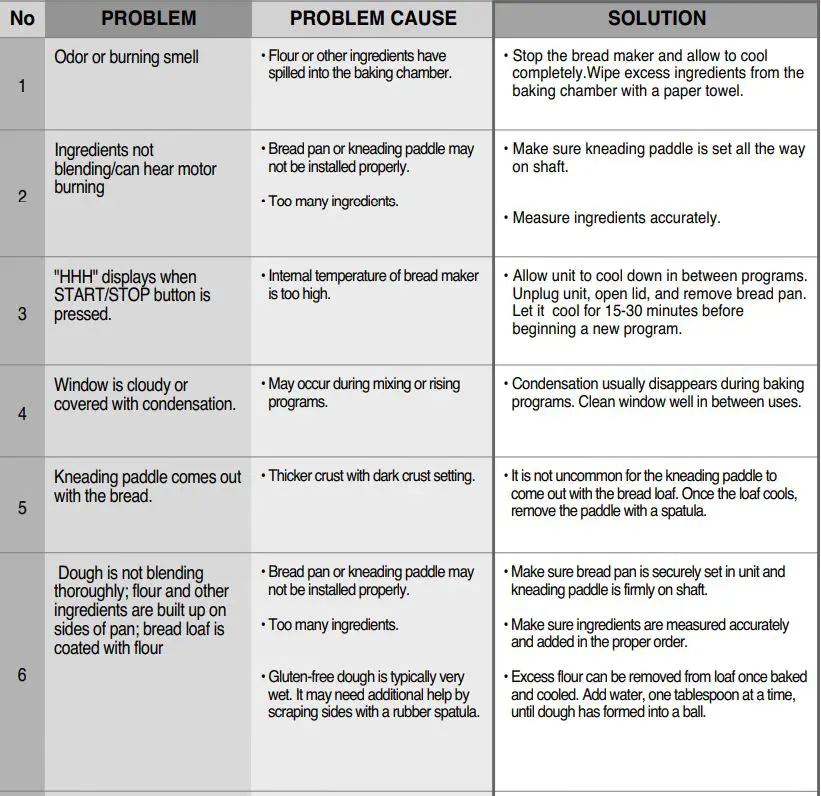







ENVIRONMENT FRIENDLY DISPOSAL
You can help protect the environment! Please remember to respect the local regulations: please dispose any non-working electrical equipment’s to an appropriate waste disposal center.![]()
![]()
RECIPE
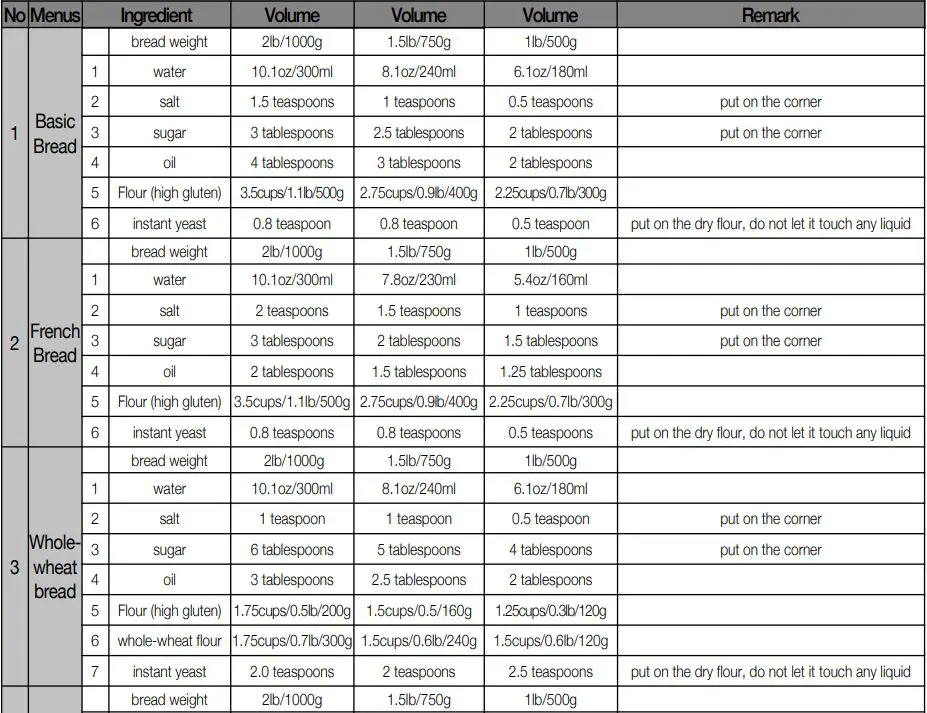







HOMEMADE PROGRAM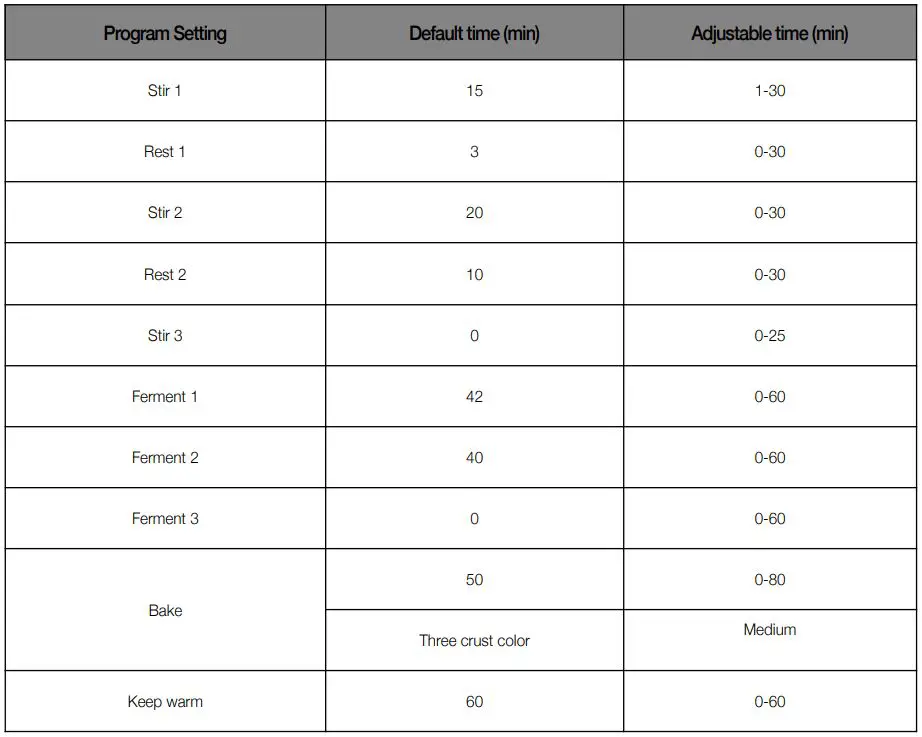

MEMO
![]()
![]()
Address : 3530 Wilshire Blvd.#1655 LA CA 90010
Z0383-0120A0
[xyz-ips snippet=”download-snippet”]

